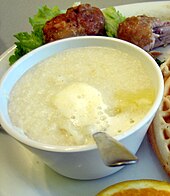Grits
 | |
| Type | Porridge |
|---|---|
| Place of origin | United States |
| Main ingredients | Ground corn |
| Variations |
|

Grits are a type of porridge made from coarsely ground dried maize or hominy,[1] the latter being maize that has been treated with an alkali in a process called nixtamalization, with the pericarp (ovary wall) removed. Grits are cooked in warm salted water or milk. They are often served with flavorings[2] as a breakfast dish. Grits can be savory or sweet, with savory seasonings being more common. Grits are similar to other thick maize-based porridges from around the world, such as polenta and mieliepap. The dish originated in the Southern United States but is now available nationwide. Grits are often part of a dinner entrée shrimp and grits, served primarily in the South.[2]
The word "grits" is derived from the Old English word grytt, meaning "coarse meal".[3] In the Charleston, South Carolina area, cooked hominy grits were primarily referred to as "hominy" until the 1980s.[4][5]
Origin[edit]
The dish originated with the Native American Muscogee tribe using maize.[6] American colonists learned to make the dish from the Native Americans, and it quickly became an American staple.[7]
At that time, maize or hominy for grits was ground on a stone mill. The ground material was passed through screens, the finer sifted material used as grit meal, and the coarser as grits.[8]
Three-quarters of the grits sold in the U.S. are bought in the South, in an area stretching from Lower Texas to Washington, D.C., that is sometimes called the "grits belt".[9] The state of Georgia declared grits to be its official prepared food in 2002.[10] A similar bill was introduced in South Carolina to name it the official state food,[11] but it did not advance.[12] Nevertheless, South Carolina still has an entire chapter of legislation dealing exclusively with corn meal and grits.[13] State law in South Carolina requires grits and rice meal to be enriched, similar to the requirement for flour.[13]
Grits may be either yellow or white, depending on the color of the maize used. The most common version in supermarkets is "quick" grits, which are made from non-hominy maize and have the germ and hull removed. Whole kernel grits are sometimes called "speckled".[14]
Preparation[edit]

Grits are prepared by mixing water or milk and the dry grits and stirring them over heat, if one uses cornmeal, the food is called mush.[15][16] Whole grain grits require much longer to become soft than "quick grits".
Dishes[edit]

Grits are eaten with a wide variety of foods, such as eggs and bacon, fried catfish, shrimp, salmon croquettes, or country ham.[17]
Shrimp and grits is a traditional dish in the coastal communities in the South Carolina Lowcountry and Georgia's Lower Coastal Plain.[18]
Solidified cooked grits can be sliced and fried in vegetable oil, butter, or bacon grease, or they can first be breaded in beaten egg and bread crumbs.[19]
See also[edit]
- Creamed corn
- Cuisine of the Southern United States
- Cuisine of the United States
- Farina (food)
- Groats
- Hasty pudding
- List of porridges
- Mush (cornmeal)
- Polenta
- Three Sisters (agriculture)
References[edit]
- ^ "Food Buying Guide for Child Nutrition Programs: Chapter 4 Grains" (PDF). Retrieved November 23, 2023.
- ^ a b Moss, Robert. "The Surprisingly Recent Story of How Shrimp and Grits Won Over the South". Serious Eats. Retrieved March 21, 2017.
- ^ Harper, Douglas. "grits". Online Etymology Dictionary. Retrieved August 27, 2011.
- ^ Lee, Matt; Lee, Ted. "Iconic Southern Plates: Lowcountry Shrimp and Grits". Southern Living. Retrieved September 3, 2022.
- ^ Huguenin, Mary Vereen; Stoney, Anne Montague, eds. (1950). Charleston Receipts. The Junior League of Charleston. p. 153.
- ^ "Shrimp and Grits: A History". Deep South Magazine. Deep South Media, LLC. October 1, 2014. Archived from the original on March 7, 2016. Retrieved September 20, 2018.
- ^ Wulff, Alexia (November 7, 2016). "A Brief History Of Grits". Culture Trip. Retrieved July 31, 2021.
- ^ Marcus, Erica (May 3, 2006). "Burning Questions: Kernels of Truth on Ground Corn". Newsday. Melville, New York: Knight Ridder Tribune Business News. p. 1 – via ProQuest.
- ^ Cutler, Charles L. (2002). Tracks that Speak: The Legacy of Native American Words in North American Culture. Boston: Houghton Mifflin. p. 28. ISBN 0-618-06510-5.
- ^ "State Prepared Food". sos.georgia.gov. Georgia Secretary of State. Archived from the original on August 29, 2008. Retrieved December 14, 2007.
- ^ "South Carolina General Assembly 113th Session, 1999–2000, Bill Number: 4806". scstatehouse.gov. South Carolina Legislature. Retrieved February 12, 2017.
- ^ "A Bill And the Code of Laws of South Carolina, 1976, By Adding Section 1-1-703 So As To Recognize Grits As the Official Food of the State. Session 113 - (1999-2000). 4806 General Bill, By Altman". scstatehouse.gov. South Carolina Legislature. Retrieved June 22, 2019.
- ^ a b "Code of Laws. Title 39. Trade and Commerce. Chapter 29. "Corn Meal and Grits"". scstatehouse.gov. South Carolina Legislature. Retrieved July 8, 2022.
- ^ Lee, Matt; Lee, Ted (April 26, 2000). "A Taste of Charleston; Corn's Highest Calling: Grits". The New York Times. Retrieved March 17, 2018.
- ^ "How to Make Grits". Better Homes and Gardens. Retrieved February 10, 2020 – via bhg.com.
- ^ "Cornmeal vs. Grits vs. Polenta". The Spruce Eats. Retrieved February 10, 2020.
- ^ "How To Cook Grits Like A Southerner". HuffPost. October 29, 2014. Retrieved February 10, 2020.
- ^ Moss, Robert (May 13, 2020). "The Surprisingly Recent Story of How Shrimp and Grits Won Over the South". seriouseats.com. Retrieved March 15, 2022.
- ^ Stacey, Leah. "Southern Fried Grit Patties". justapinch.com. Just A Pinch Recipe Club. Retrieved March 15, 2022.
